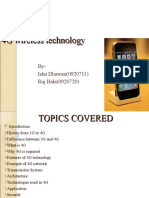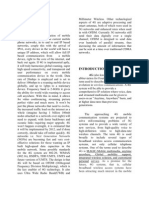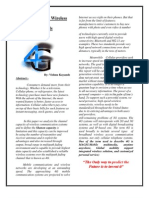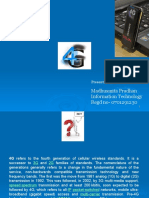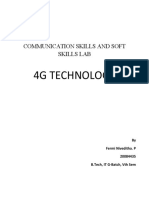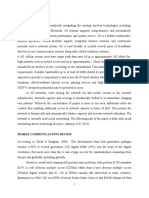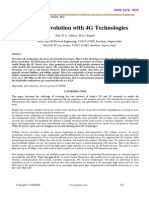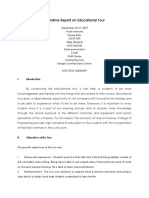0 ratings0% found this document useful (0 votes)
33 viewsRikka Comms
Rikka Comms
Uploaded by
Ginu Rodavia Dela Torre4G is the fourth generation of broadband cellular network technology that provides faster speeds and improved capabilities over 3G networks. Key features of 4G include support for high-speed multimedia services, IP networking, and improved spectral efficiency. Potential applications of 4G include mobile web access, IP telephony, mobile TV, video conferencing, and wireless sensor networks. 4G networks use various radio frequencies for connectivity and allow innovative applications in areas like public safety monitoring, intelligent transportation, and traffic management.
Copyright:
© All Rights Reserved
Available Formats
Download as DOCX, PDF, TXT or read online from Scribd
Rikka Comms
Rikka Comms
Uploaded by
Ginu Rodavia Dela Torre0 ratings0% found this document useful (0 votes)
33 views7 pages4G is the fourth generation of broadband cellular network technology that provides faster speeds and improved capabilities over 3G networks. Key features of 4G include support for high-speed multimedia services, IP networking, and improved spectral efficiency. Potential applications of 4G include mobile web access, IP telephony, mobile TV, video conferencing, and wireless sensor networks. 4G networks use various radio frequencies for connectivity and allow innovative applications in areas like public safety monitoring, intelligent transportation, and traffic management.
Original Description:
4G
Copyright
© © All Rights Reserved
Available Formats
DOCX, PDF, TXT or read online from Scribd
Share this document
Did you find this document useful?
Is this content inappropriate?
4G is the fourth generation of broadband cellular network technology that provides faster speeds and improved capabilities over 3G networks. Key features of 4G include support for high-speed multimedia services, IP networking, and improved spectral efficiency. Potential applications of 4G include mobile web access, IP telephony, mobile TV, video conferencing, and wireless sensor networks. 4G networks use various radio frequencies for connectivity and allow innovative applications in areas like public safety monitoring, intelligent transportation, and traffic management.
Copyright:
© All Rights Reserved
Available Formats
Download as DOCX, PDF, TXT or read online from Scribd
Download as docx, pdf, or txt
0 ratings0% found this document useful (0 votes)
33 views7 pagesRikka Comms
Rikka Comms
Uploaded by
Ginu Rodavia Dela Torre4G is the fourth generation of broadband cellular network technology that provides faster speeds and improved capabilities over 3G networks. Key features of 4G include support for high-speed multimedia services, IP networking, and improved spectral efficiency. Potential applications of 4G include mobile web access, IP telephony, mobile TV, video conferencing, and wireless sensor networks. 4G networks use various radio frequencies for connectivity and allow innovative applications in areas like public safety monitoring, intelligent transportation, and traffic management.
Copyright:
© All Rights Reserved
Available Formats
Download as DOCX, PDF, TXT or read online from Scribd
Download as docx, pdf, or txt
You are on page 1of 7
4G
It is the fourth generation of broadband cellular
network technology, succeeding 3G. A 4G system must provide
capabilities defined by ITU in IMT Advanced. Potential and
current applications include amended mobile web access, IP
telephony, gaming services, high-definition mobile TV, video
conferencing, and 3D television.
Why I choose 4g?
I heard that 4G is better than 3G. I’m curious how it does
happen, how it works and I want to learn more about its
features, applications and advantages.
4G Features
Support for interactive multimedia, voice, streaming video,
Internet, and other broadband services
IP based mobile system
High speed, high capacity, and low cost per bit
Global access, service portability, and scalable mobile
services
Seamless switching, and a variety of Quality of Service
driven services
Better scheduling and call admission control techniques
Ad hoc and multi hop networks (the strict delay
requirements of voice make multi hop network service a
difficult problem)
Better spectral efficiency
Seamless network of multiple protocols and air interfaces
(since 4G will be all •]IP, look for 4G systems to be
compatible with all common network technologies,
including802.11, WCDMA, Blue tooth, and Hyper LAN).
An infrastructure to handle preexisting 3G systems along
with other wireless technologies, some of which are
currently under development.
4G technologies are significant because users joining
the network add mobile routers to the network infrastructure.
Because users carry much of the network with them, network
capacity and coverage is dynamically shifted to accommodate
changing user patterns. As people congregate and create pockets
of high demand, they also create additional routes for each
other, thus enabling additional access to network capacity.
Users will automatically hop away from congested routes to less
congested routes. This permits the network to dynamically and
automatically self-balance capacity, and increase network
utilization. What may not be obvious is that when user devices
act as routers, these devices are actually part of the network
infrastructure.
So instead of carriers subsidizing the cost of user
devices (e.g., handsets, PDAs, of laptop computers), consumers
actually subsidize and help deploy the network for the carrier.
With a cellular infrastructure, users contribute nothing to the
network. They are just consumers competing for resources. But in
wireless ad hoc peer-to-peer networks, users cooperate - rather
than compete - for network resources. Thus, as the service gains
popularity and the number of user’s increases, service likewise
improves for all users. And there is also the 80/20 rules.
With traditional wireless networks, about 80% of the
cost is for site acquisition and installation, and just 20% is
for the technology. Rising land and labor costs means
installation costs tend to rise over time, subjecting the
service providers 7 business models to some challenging issues
in the out years. With wireless peer-to-peer networking,
however, about 80% of the cost is the technology and only 20% is
the installation. Because technology costs tend to decline over
time, a current viable business model should only become more
profitable over time. The devices will get cheaper, and service
providers will reach economies of scale sooner because they will
be able to pass on the infrastructure savings to consumers,
which will further increase the rate of penetration.
Application of 4g
4G Car
With the hype of 3G wireless in the rear view mirror,
but the reality of truly mobile broadband data seemingly too far
in the future to be visible yet on the information super
highway, it may seem premature to offer a test drive 4G. But the
good news is, 4G is finally coming to a showroom near you.
4G and public safety:
There are sweeping changes taking place in
transportation and intelligent highways generally referred to as
“Intelligent Transportation Systems” (ITS). “ITS” is comprised
of a number of technologies, including information processing,
communications, control, and electronics. Using these
technologies with our transportation systems, and allowing first
responders access to them, will help prevent or certainly
mitigate future disasters. Communications, and the cooperation
and collaboration it affords, is a key element of any effective
disaster response. Historically, this has been done with bulky
handheld radios that provide only voice to a team in a common
sector. Furthermore, this architecture is still cellular, with
singular point of failure, because all transmissions to a given
cell must pass through that one cell. If the cell tower is
destroyed in the disaster traditional wireless service is
eliminated.
Sensors in public vehicle
Putting a chemical-biological-nuclear (CBN) warning
sensor on every government-owned vehicle instantly creates a
mobile fleet that is the equivalent of an army of highly trained
dogs. As these vehicles go about their daily duties of law
enforcement, garbage collection, sewage and water maintenance,
etc., municipalities get the added benefit of early detection of
CBN agents. The sensors on the vehicles can talk to fixed
devices mounted on light poles throughout the area, so positive
detection can be reported in real time. And since 4G networks
can include inherent geo-location without GPS, first responders
will know where the vehicle is when it detects a CBN agent.
Cameras In traffic light:
Some major cities have deployed cameras on traffic
lights and send those images back to a central command center.
This is generally done using fiber, which limits where the
cameras can be hung, i.e, no fiber, and no camera. 4G networks
allow cities to deploy cameras and backhaul them wirelessly. And
instead of having to backhaul every camera, cities can backhaul
every third or fifth or tenth camera, using the other cameras as
router/repeaters. These cameras can also serve as fixed
infrastructure devices to support the mobile sensor application
described above.
History of 4G
The first-release Long Term Evolution (LTE) standard was
commercially deployed in Oslo, Norway, and Stockholm, Sweden in
2009, and has since been deployed throughout most parts of the
world. It has, however, been debated whether first-release
versions should be considered 4G LTE.
The 4G system was originally envisioned by the DARPA -
the US Defense Advanced Research Projects Agency.DARPA selected
the distributed architecture and end-to-end Internet protocol
(IP), and believed at an early stage in peer-to-peer networking
in which every mobile device would be both a transceiver and a
router for other devices in the network, eliminating the spoke-
and-hub weakness of 2G and 3G cellular systems. Since the 2.5G
GPRS system, cellular systems have provided dual
infrastructures: packet switched nodes for data services, and
circuit switched nodes for voice calls. In 4G systems, the
circuit-switched infrastructure is abandoned and only a packet-
switched network is provided, while 2.5G and 3G systems require
both packet-switched and circuit-switched network nodes, i.e.
two infrastructures in parallel. This means that in 4G
traditional voice calls are replaced by IP telephony
Advantages of 4G
Quickly download files over a wireless network.
Extremely high voice quality.
Easily access Internet, IM, social networks, streaming media,
video calling.
Higher bandwidth.
4G is 10 times faster than 3G.
Disadvantages of 4g
New frequencies means new components in cell tower
Higher data prices for consumers
Consumer is forced to buy a new device to support 4g
It is impossible to make your current equipment compatible
with the 4G network
Frequencies for 4G LTE networks
Mobile 4G network uses several frequencies:
700 MHz (Band 28 - Telstra / Optus)
850 MHz (Band 5 - Vodafone)
900 MHz (Band 8 - Telstra)
1800 MHz (Band 3 - Telstra / Optus / Vodafone)
2100 MHz (Band 1 - [a small number of Telstra sites] /
Optus [Tasmania] / Vodafone)
2300 MHz (Band 40 - Optus [Vivid Wireless spectrum])
2600 MHz (Band 7 - Telstra / Optus)
In Australia, the 700 MHz band was previously used for
analogue television and became operational with 4G in December
2014.The 850 MHz band is currently operated as a 3G network by
Telstra and as a 4G network by Vodafone in Australia.
Summary of Learnings
I learned that a 4g modern technology had many applications
like 4G car, 4G and public safety, Sensors in public vehicle.4G
also had a power to help us to improve our internet connection
in terms of searching and downloading. A 4G Modern Technology is
the fourth Generation Mobile Network Technology. 4G will replace
3G in the future; 4G provides a more reliable connection and
higher speeds to people. 4G LTE means fourth generation long
term evolution. LTE is a kind of 4G that provides fastest
connection to mobile Internet experience-10 times faster than
3G.
You might also like
- 4G TechnologyDocument26 pages4G TechnologytheshlagNo ratings yet
- Issues in Mobility Management in 4G Networks: AbstractDocument16 pagesIssues in Mobility Management in 4G Networks: AbstractHan JeeNo ratings yet
- Presentation On 4G Wireless TechnologyDocument60 pagesPresentation On 4G Wireless TechnologycheezeshaNo ratings yet
- CCCCCCCCCCCCCCCCCCC C C CCCCCCCCCCCCDocument13 pagesCCCCCCCCCCCCCCCCCCC C C CCCCCCCCCCCCNarendar Reddy DonthidiNo ratings yet
- An Insight To 4 Generation Wireless SystemDocument11 pagesAn Insight To 4 Generation Wireless Systemvenkat4uuuNo ratings yet
- 4G Wireless System: K.Sudha Rani G.SruthiDocument20 pages4G Wireless System: K.Sudha Rani G.SruthiSudha Reddy KuluruNo ratings yet
- Goals of True Broad Band's Wireless Next Wave (4G-5G)Document5 pagesGoals of True Broad Band's Wireless Next Wave (4G-5G)alokcena007No ratings yet
- Value Added Service Management in 4G Networks For Mobile CommunicationDocument6 pagesValue Added Service Management in 4G Networks For Mobile CommunicationRavinder ThakurNo ratings yet
- ACN Assign - Jyotimoi - I079 PDFDocument12 pagesACN Assign - Jyotimoi - I079 PDFJyotimoiHazarikaNo ratings yet
- V5N12 118Document6 pagesV5N12 118Suzi MargretNo ratings yet
- 4g Communications Rajendar BitsDocument16 pages4g Communications Rajendar BitssaddamhussainmdNo ratings yet
- PapersDocument5 pagesPapersDivyang ShuklaNo ratings yet
- Paper Presentation On 4G Technology: Presented by K.CHARISHA& K.Ganga Bhavani B.Tech, ECE III YearDocument7 pagesPaper Presentation On 4G Technology: Presented by K.CHARISHA& K.Ganga Bhavani B.Tech, ECE III YearGanga BhavaniNo ratings yet
- Ict ReportDocument13 pagesIct ReportSANTOSH GAIKWADNo ratings yet
- 4G Technology: Department of Computer Engineering, D.Y.P.I.E.TDocument28 pages4G Technology: Department of Computer Engineering, D.Y.P.I.E.Tdinu8086No ratings yet
- "4G Technology": A Seminar Report OnDocument16 pages"4G Technology": A Seminar Report OnRohit SoniNo ratings yet
- 4G Mobile Communication SystemDocument21 pages4G Mobile Communication SystemMohan GargNo ratings yet
- Name - Mohit Agarwal Roll No. - 0803331057 Guide Wriddhi BhowmikDocument27 pagesName - Mohit Agarwal Roll No. - 0803331057 Guide Wriddhi BhowmikMohit AgarwalNo ratings yet
- Technology: By-Sibendu Mandal Ece 8 SEM ROLL NO-08182003044Document26 pagesTechnology: By-Sibendu Mandal Ece 8 SEM ROLL NO-08182003044Subir MaityNo ratings yet
- 4G Seminar ReportDocument31 pages4G Seminar ReportFazil AliNo ratings yet
- 4G Wireless Systems: Yuben JosephDocument8 pages4G Wireless Systems: Yuben JosephHashmi EugineNo ratings yet
- 4g Technology AbstractDocument3 pages4g Technology AbstractPurnima KNo ratings yet
- Fourth Generation Wireless Systems 4G: AbstractDocument10 pagesFourth Generation Wireless Systems 4G: AbstractHarsha CharanreddyNo ratings yet
- 4g Wireless SystemsDocument29 pages4g Wireless SystemsGajendra ShankhwarNo ratings yet
- 5G Mobile Technology: Abstract-Existing Research Work in Mobile Communication Is Related To 5G Technology. in 5GDocument5 pages5G Mobile Technology: Abstract-Existing Research Work in Mobile Communication Is Related To 5G Technology. in 5GA RNo ratings yet
- "4G Technology": Sri Venkateswara College of Eng & Tech.Document9 pages"4G Technology": Sri Venkateswara College of Eng & Tech.Venkatesh ChowdaryNo ratings yet
- 4 4g Wireless Systems OrgDocument31 pages4 4g Wireless Systems OrgrbakoliaNo ratings yet
- 4G Mobile TechnologyDocument19 pages4G Mobile TechnologyHani TaHaNo ratings yet
- 4g Wireless TechnologyDocument25 pages4g Wireless Technologykrmukesh100% (1)
- 4G Wireless Network: Acct Cis500Document6 pages4G Wireless Network: Acct Cis500Saikat HalderNo ratings yet
- Generations of Wireless Mobile Systems: Comparison of Channel Capacity For Different Channel TypesDocument2 pagesGenerations of Wireless Mobile Systems: Comparison of Channel Capacity For Different Channel TypesFranch Maverick Arellano LorillaNo ratings yet
- 4g Technology Seminar Report PDFDocument12 pages4g Technology Seminar Report PDFPriyanshu Kumar100% (6)
- Index: Sr. No. TopicDocument18 pagesIndex: Sr. No. TopicDinesh ChahalNo ratings yet
- Next Generation Wireless Standards: By: Vishnu Kayande AbstractDocument7 pagesNext Generation Wireless Standards: By: Vishnu Kayande AbstractLonar SarovarNo ratings yet
- Madhusmita Pradhan Information Technology Regd No-0701291230Document12 pagesMadhusmita Pradhan Information Technology Regd No-0701291230abakashdNo ratings yet
- A Synopsis On: 4G Wireless SystemDocument5 pagesA Synopsis On: 4G Wireless SystemUdgam TiwariNo ratings yet
- 4G NotesDocument7 pages4G NoteskavithachennaNo ratings yet
- Wireless Communications: Seminor Topic OnDocument9 pagesWireless Communications: Seminor Topic OnPraveen KumarNo ratings yet
- 5 GDocument26 pages5 GRani ManugrahaniNo ratings yet
- 4G Technology: Team: Commwarrior Leela VatiDocument9 pages4G Technology: Team: Commwarrior Leela VatimalonanNo ratings yet
- 4G Wireless ReportDocument15 pages4G Wireless ReportAbi JaneNo ratings yet
- 5G Mobile TechnologiesDocument8 pages5G Mobile Technologiesசெல்வம் கருணாநிதிNo ratings yet
- Current Trends and Future of 4G Technologies - 4G TechnologyDocument9 pagesCurrent Trends and Future of 4G Technologies - 4G Technologydummy12345No ratings yet
- 4G Technologies: Jishnu.S, Iii-Cse, Hindusthan Institute of TechnologyDocument12 pages4G Technologies: Jishnu.S, Iii-Cse, Hindusthan Institute of TechnologyJishnu NairNo ratings yet
- Presentation On: Rajat Singla It-B 274109Document25 pagesPresentation On: Rajat Singla It-B 274109Garima KapoorNo ratings yet
- 4g Magic CommunicationDocument3 pages4g Magic CommunicationKashish PariNo ratings yet
- Security Enhancement in MANET With 4GDocument4 pagesSecurity Enhancement in MANET With 4GSilverline HartNo ratings yet
- Seminar On 4G Technology: Prensented byDocument19 pagesSeminar On 4G Technology: Prensented byAdityansh UpadhyayNo ratings yet
- 4G Technology: Communication Skills and Soft Skills LabDocument5 pages4G Technology: Communication Skills and Soft Skills LabFermi NivedithaNo ratings yet
- CT-539 Advance Computer Networking Report On,: 5G Wireless System'Document11 pagesCT-539 Advance Computer Networking Report On,: 5G Wireless System'Khawaja RameezNo ratings yet
- John Appl 4GDocument12 pagesJohn Appl 4GAnnonymous963258No ratings yet
- 4G Americas Rysavy LTE and 5G InnovationDocument117 pages4G Americas Rysavy LTE and 5G Innovationlouie mabini100% (1)
- Bimbo SeminarDocument19 pagesBimbo Seminargolden abidemNo ratings yet
- A Paper Presentation ON: Magic CommunicationDocument16 pagesA Paper Presentation ON: Magic CommunicationMohammed FaizanNo ratings yet
- Wireless Evolution With 4G Technologies: Prof. D. U. Adokar, Priti J. RajputDocument11 pagesWireless Evolution With 4G Technologies: Prof. D. U. Adokar, Priti J. RajputNebiye SolomonNo ratings yet
- 4G Wireless TechnologyDocument3 pages4G Wireless TechnologyEditor IJTSRDNo ratings yet
- 4g - Mobile CommunicationDocument11 pages4g - Mobile CommunicationsrinivascbitNo ratings yet
- User Demands and Wireless Technologies: Global Mobile AccessDocument44 pagesUser Demands and Wireless Technologies: Global Mobile AccessSihirli HazineNo ratings yet
- The 5G Revolution: How the Next Generation of Wireless Will Change EverythingFrom EverandThe 5G Revolution: How the Next Generation of Wireless Will Change EverythingNo ratings yet
- ThesisDocument31 pagesThesisGinu Rodavia Dela TorreNo ratings yet
- Virata 007Document27 pagesVirata 007Ginu Rodavia Dela TorreNo ratings yet
- Carbon Monoxide (CO) Concentration Monitoring System: Krizzia May L. GuimpolDocument38 pagesCarbon Monoxide (CO) Concentration Monitoring System: Krizzia May L. GuimpolGinu Rodavia Dela TorreNo ratings yet
- Design of Active Filter For 5Khz, 10Khz and 20KhzDocument19 pagesDesign of Active Filter For 5Khz, 10Khz and 20KhzGinu Rodavia Dela TorreNo ratings yet
- Development of Pothole Detection and Filler Using Arduino Mega 2560Document48 pagesDevelopment of Pothole Detection and Filler Using Arduino Mega 2560Ginu Rodavia Dela TorreNo ratings yet
- Motherboard DetectorDocument28 pagesMotherboard DetectorGinu Rodavia Dela TorreNo ratings yet
- An Introduction To Bluetooth TechnologyDocument43 pagesAn Introduction To Bluetooth TechnologyGinu Rodavia Dela TorreNo ratings yet
- Pothole FillerDocument37 pagesPothole FillerGinu Rodavia Dela TorreNo ratings yet
- Estallo Thesis Final DefenseDocument23 pagesEstallo Thesis Final DefenseGinu Rodavia Dela TorreNo ratings yet
- Bluetooth DelatorreDocument11 pagesBluetooth DelatorreGinu Rodavia Dela TorreNo ratings yet
- Narrative Report On Educational TourDocument7 pagesNarrative Report On Educational TourGinu Rodavia Dela TorreNo ratings yet
- DMSCO Log Book Vol.50 1972Document57 pagesDMSCO Log Book Vol.50 1972Des Moines University Archives and Rare Book RoomNo ratings yet
- Mitani, Hiroshi - The Concept of AsiaDocument15 pagesMitani, Hiroshi - The Concept of AsiaKarina Cads100% (1)
- One Direction Thesis StatementDocument6 pagesOne Direction Thesis Statementafibaubdfmaebo100% (2)
- Project On: "Analysis of Fianancial Performance of Sezal Glass Limited in Mumbai"Document61 pagesProject On: "Analysis of Fianancial Performance of Sezal Glass Limited in Mumbai"Bhavika KarkeraNo ratings yet
- Plush Velvet Monkey Amigurumi PDF Free Crochet Pattern - AmigurumidayDocument6 pagesPlush Velvet Monkey Amigurumi PDF Free Crochet Pattern - Amigurumidaydilatador05.organzaNo ratings yet
- One-Way Slab Design: (Based On BS8110:2000-Part1)Document2 pagesOne-Way Slab Design: (Based On BS8110:2000-Part1)mayphyo100% (1)
- Samsara Vilasa (3 & 4BHK) Sector 63Document10 pagesSamsara Vilasa (3 & 4BHK) Sector 63sushil aroraNo ratings yet
- Chad Walker Resume 2021may 2021kcrev2Document2 pagesChad Walker Resume 2021may 2021kcrev2api-479212944No ratings yet
- Taxation of Foreign Nationals - Tax Law in IndiaDocument2 pagesTaxation of Foreign Nationals - Tax Law in IndiaSankaram KasturiNo ratings yet
- Understanding The Challenges of The Adult LearningDocument9 pagesUnderstanding The Challenges of The Adult LearningMaviel Maratas Sarsaba63% (8)
- Essay About Science and Technology in The UsaDocument18 pagesEssay About Science and Technology in The UsaLuis RodriguezNo ratings yet
- Final ResearchDocument14 pagesFinal Researchcharles granada88% (8)
- 8877 Piano-1Document7 pages8877 Piano-1Gloria CampioliNo ratings yet
- Integrated Chinese - Level 1 Part 1 - Vocabulary by LessonDocument33 pagesIntegrated Chinese - Level 1 Part 1 - Vocabulary by LessonSerenango100% (1)
- Words Clothed in Light Dhikr Recollectio PDFDocument15 pagesWords Clothed in Light Dhikr Recollectio PDFangger aminda noorcipta joharNo ratings yet
- Nature Cure Centre@mahendragiri FoothillsDocument3 pagesNature Cure Centre@mahendragiri Foothillsrathish100% (1)
- Thesis AfaanOromoo 2016Document93 pagesThesis AfaanOromoo 2016lamrotgetaw15No ratings yet
- 02 PMP Practice Exam Question Bank - April 2022Document84 pages02 PMP Practice Exam Question Bank - April 2022chiakpNo ratings yet
- Rubiks Cube SolverDocument10 pagesRubiks Cube Solverbrizmar07No ratings yet
- Seminar On: Earthquake Resistant TechniquesDocument26 pagesSeminar On: Earthquake Resistant TechniquesrohitNo ratings yet
- Ra 9165 Chain of Custody (Del Castillo)Document2 pagesRa 9165 Chain of Custody (Del Castillo)PROP ANDREOMSNo ratings yet
- Francis Bacon - BiographyDocument7 pagesFrancis Bacon - BiographytomsillimoottilNo ratings yet
- Abuan v. Garcia (Villarama)Document1 pageAbuan v. Garcia (Villarama)Binkee VillaramaNo ratings yet
- Tax 1 PrimerDocument113 pagesTax 1 PrimerPatrice De CastroNo ratings yet
- Information Sheet For Applicants For Employers of Indonesia Candidates For "Kangoshi"Document10 pagesInformation Sheet For Applicants For Employers of Indonesia Candidates For "Kangoshi"bnp2tkidotgodotidNo ratings yet
- Fourteenth Edition: Global E-Business and CollaborationDocument49 pagesFourteenth Edition: Global E-Business and CollaborationSabelo RonNo ratings yet
- Unit 4 Infinitives Vs GerundsDocument3 pagesUnit 4 Infinitives Vs GerundsDaniela Orozco BringasNo ratings yet
- Brazilian Food You Ought TotryDocument2 pagesBrazilian Food You Ought Totrythx1138gaNo ratings yet
- Hybrid English 4 Q2 M5 W5Document11 pagesHybrid English 4 Q2 M5 W5Jedasai PasambaNo ratings yet
- Fin433 ReportDocument30 pagesFin433 ReportShàhríàrõ Dã Ràkínskì100% (1)


